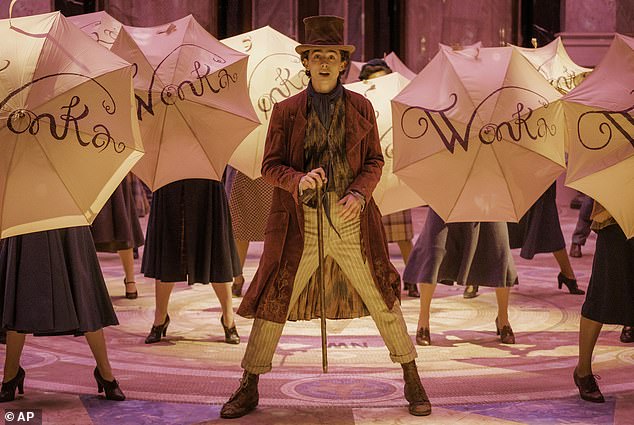The internet has been in meltdown for the past two weeks, after visitors to an immersive Willy Wonka experience in Glasgow found themselves in a run-down warehouse bedecked with half-hearted decorations and embarrassed actors in ‘pound-shop’ costumes.
It is easy to see the funny side, but attendees had shelled out £35 per head to attend, only to find that what had been billed as a ‘chocolate fantasy’, saw some of their kids handed just one jellybean and a third of a cup of lemonade.
In reality, they found that they had been misled into attending to an event that hadn’t even stocked enough chocolate for the guests, and ended with the police being called.

The disastrous event in Glasgow was billed as a ‘chocolate fantasy’ according to promotional material
Part of the reason for the event’s failure was that the adverts for the event and even the actors’ scripts were generated using artificial intelligence.
This was no doubt used by the organisers tomake the event look far more professional than it was – but you only needed to scratch the surface to realise that the adverts were full of mistakes, and the scripts didn’t make sense.
AI, is also being used increasingly by scammers – and often in much more sophisticated ways – meaning it is important to be able to spot the signs.
Laura Hendry Parsons, privacy advocate at internet security firm ExpressVPN, said: ‘While we’ve seen false adverts, and “deepfake” images and videos before, the recent advancements of AI tools combined with their ease of access has meant incredibly realistic videos and images can now be created that look like near-identical versions of the real thing.’
We asked two experts how to spot the signs of an AI-generated scam, and avoid falling into their trap.
The devil is in the details
At first, an AI image might seem normal, or even realistic – but take notice of the finer details, and you might begin to notice that things don’t seem quite right.
Joe Davies, founder of marketing agency FatJoe recommends that inspecting images of people or animals is your first port of call.
‘Pay close attention to the fingers. You might see extra fingers, missing fingers, abnormally long or short fingers, unnatural bends, or fingers that blend together,’ he says.
‘Other small features such as ears, eyes, and toes can also be distorted. Weird body proportions are another red flag for AI involvement.’
Faces, in particular, are difficult for AI to replicate accurately, Hendry Parsons says.
‘Some visual cues include poor blending of facial features, like the inconsistencies in skin tone, shadows, or even blurry and distorted areas of the face,’ she added.
Similarly, common objects will often appear oddly positioned or distorted: ‘AI might place a pen upside down in a hand, or you’ll see a spoon floating on top of a bowl of soup,’ she says.
‘Jewellery is another small detail that AI can get wrong, with mismatched earrings or rings that don’t go all the way around the finger,’ Davies added.

Joe Davies says AI detection tools can be used to weed out AI adverts
Backgrounds and lighting can be a giveaway
When it comes to backgrounds, ‘AI can get lazy’, Davies said.
‘Text in the background might look fine at first glance, but upon closer inspection you’ll find it’s complete gibberish.
‘Patterns in backgrounds, such as wallpaper or tile floors, can also betray AI. These might start repeating in unnatural ways or abruptly change pattern for no reason. This happens because AI struggles to understand continuity.’
AI can also struggle to create accurate shadows, with dark spots not corresponding to sources of light in the image, or a person’s face appearing brightly lit despite an otherwise dim setting.
Davies added that texture can also prove difficult, with human skin appearing overly smooth, hair as a single mass rather than individual strands, and fabrics not flowing in a natural way.
Writing isn’t AI’s strong suit
Another sign that an advert or communication is fake is seeing lots of mistakes in the writing.

Punters at the Wonka event were greeted by a drab warehouse fitted out with scattered decorations – nothing like the AI-generated advert
‘Unfortunately, AI can empower bad actors by lowering the barrier for entry to create high level scam content – but while AI text generation has developed to incredible levels in the past year, the technology is still prone to errors,’ Hendry Parsons told This is Money.
‘Thankfully, this can sometimes give the game away and reveal the advert as a scam. People should look out for simple errors, whether they be spelling mistakes or unusual phrases or a tone of voice that you don’t see in a typical advert.
‘This might alert you to the fact that the advert is in fact a scam, and has been created by a computer to mimic a real brand.’
Taking the time to scroll to the bottom of the ‘Willy’s Chocolate Experience’ website would have revealed one promotional image promising ‘Catgacating. Live perfornmances. Cartchy tuns, exarserdray lollipops, a pasadise of sweet teats’.
Stopping to read the advert, it may have become clear to visitors that they were not about to receive the ‘Encherining Enterainment’ advertised.
How can I check if the ad is a scam?
If the advert doesn’t appear on any mainstream website, or is on a website with an unusual URL and lots of pop-up adverts and links, warning lights should be flashing.
In order to check, Hendry Parsons suggests a reverse image search – especially if something looks too good to be true.
‘To the untrained eye, these adverts usually look safe, but by doing a reverse image search you may be able to see if the advert, and particularly the image within it, has appeared elsewhere or on more prominent sites – meaning it is more likely to be genuine.’ She said.
FatJoe’s Davies added that AI detection tools, such as the websites ‘Is it AI?’ and ‘AI or not’ can be used to verify content online.
‘These tools use sophisticated algorithms to look for inconsistencies and giveaways typical of AI creations,’ he says. ‘They’re not foolproof though, so don’t take the result as 100 per cent fact.’

The sham immersive experience looked to capitalise on the success of ‘Wonka’ starring Timothee Chalamet
What can I do if I think I’ve been scammed?
Even if you take precautions, it is possible that you might still fall for a scam.
If you have paid for something that you don’t think is genuine, or given away your personal or credit card details to someone you don’t think you should have, there are still ways to get your money back.
‘Call your bank or credit card provider’s fraud number immediately and report that a scam has taken place’ Hendry Parsons told This is Money. ‘If a third-party payment application was involved, such as PayPal, contact them immediately too – this will increase the chances of the money being returned to you.’
‘If you have entered any account information into the fake site, such as your email address or bank details, change the passwords of the accounts concerned as soon as possible and enable two-factor authentication to ensure no one else can access these accounts.’
She added that you should report the scam to the police or to Action Fraud.
Some links in this article may be affiliate links. If you click on them we may earn a small commission. That helps us fund This Is Money, and keep it free to use. We do not write articles to promote products. We do not allow any commercial relationship to affect our editorial independence.



